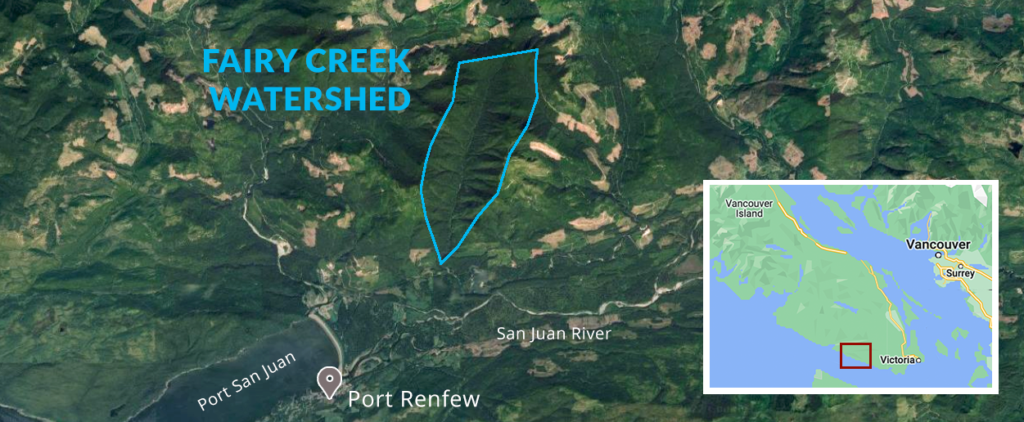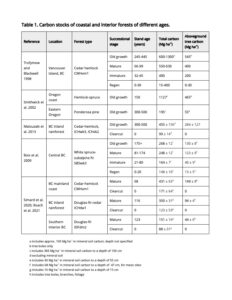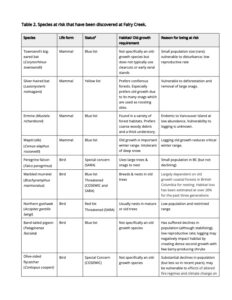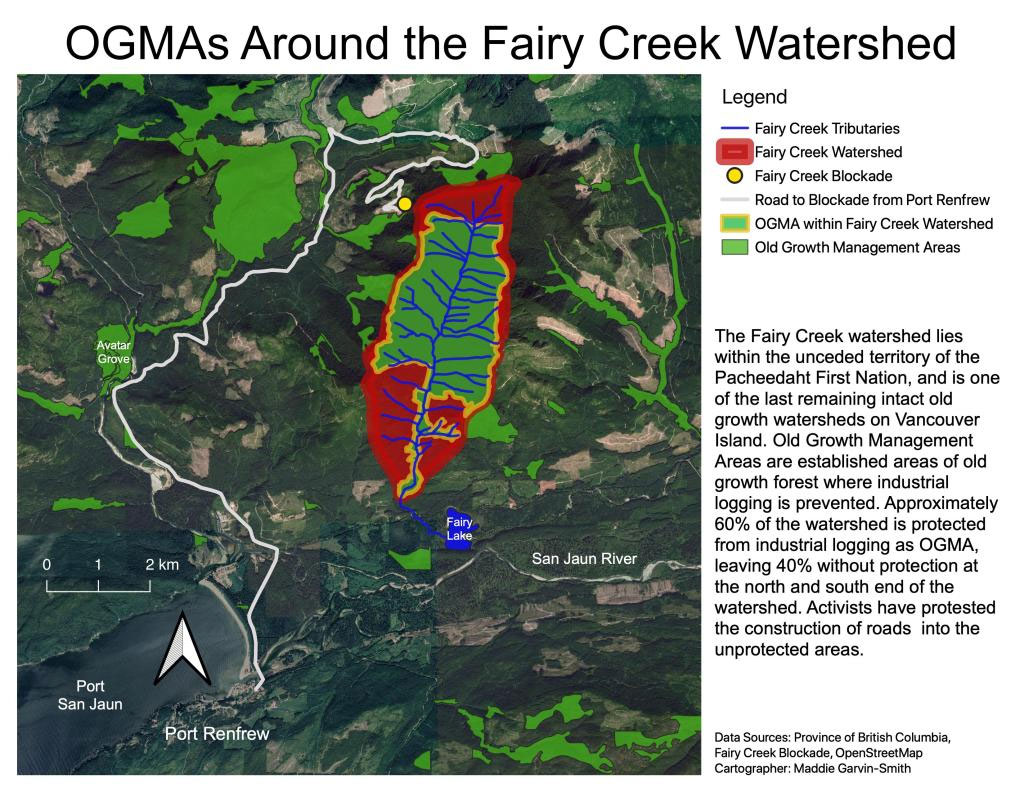FAIRY CREEK
Highlights
- The Fairy Creek watershed is the last unlogged old growth valley on southern Vancouver Island outside of parks and is situated within a landscape that has been highly disturbed by logging.
- The Fairy Creek watershed includes some of Canada’s wettest and most productive forest sites and about 75% of the forest in the watershed is old (>250 years), with individual trees estimated to be more than 1000 years old.
- Over 400 species of plants and animals rely on BC’s old growth forests for at least part of their life cycle. As of February 18, 2022, 326 species (plants, animals, birds, etc.) have been sighted and recorded in the Fairy Creek watershed, including 17 species that are at risk.
- On sites like Fairy Creek, old forests are estimated to store twice as much carbon as mature forests and six or more times as much as clearcuts. Productive coastal old forests can store up to six times more carbon than old forests in drier climatic areas.
Overview
Fairy Creek is a small (1,189 hectare) forested watershed located in Pacheedaht First Nation territory northeast of Port Renfrew and 130 km northwest of Victoria on southwestern Vancouver Island, British Columbia (BC).
It is the last unlogged old-growth valley on southern Vancouver Island outside of parks and is situated within a broadly disturbed landscape.
About 75% of the forest in the watershed is old (>250 years), with individual trees estimated to be more than 1000 years old, reflecting the absence of widespread disturbance within the watershed. These old trees include a 2.9-meter diameter yellow cedar, which is the nineth widest known yellow cedar in Canada according to the BC Big Tree Registry.

Site Characteristics
Carbon Storage
In the wet, productive CWHvmCWHvm is the abbreviation for the very wet maritime Coastal Western Hemlock biogeoclimatic subzone. The province of British Columbia is divided into 16 zones, including the Coastal Western Hemlock (CWH). A zone is a large geographic area with a relatively uniform regional climate. The CWH zone is subdivided into climatically distinct subzones, including the vm, or very wet maritime subzone. The CWHvm has a wet, humid, mild, oceanic climate and has an extensive distribution on the BC coast including western Vancouver Island. More subzone in coastal BC, which is where Fairy Creek occurs, old forests have been estimated to store twice as much carbon as mature forests and six or more times as much as clearcuts (Trofymow and Blackwell, 1998Trofymow, J.A., Blackwell, B. 1998. Changes in ecosystem mass and carbon distributions in coastal forest chronosequences. Pgs. 40-42 In: Trofymow, J.A. and A. MacKinnon, eds. Proceedings of a Workshop on Structure, Process, and Diversity in Successional Forests of Coastal British Columbia, February 17-19, 1998, Victoria, British Columbia. Northwest Sci. 72 (special issue No. 2). More; Simard et al., 2020Simard, S.W., Roach, W.J., Defrenne, C.E., Pickles, B.J., Snyder, E.N., Robinson, A, Lavkulich, L.M. 2020. Harvest intensity effects on carbon stocks and biodiversity are dependent on regional climate in Douglas-Fir forests of British Columbia. Front. For. Glob. Chang. https://doi.org/10.3389/ffgc.2020.00088 More; Roach et al., 2021Roach, W.J., Simard, S.W., Defrenne, C.E., Pickles, B.J., Lavkulich, L.M., Ryan, T.L. 2021. Tree diversity, site index, and carbon storage decrease with aridity in Douglas-fir forests in western Canada. Front. For. Glob. Change 4:682076. More) (Table 1). Also in the CWHvmCWHvm is the abbreviation for the very wet maritime Coastal Western Hemlock biogeoclimatic subzone. The province of British Columbia is divided into 16 zones, including the Coastal Western Hemlock (CWH). A zone is a large geographic area with a relatively uniform regional climate. The CWH zone is subdivided into climatically distinct subzones, including the vm, or very wet maritime subzone. The CWHvm has a wet, humid, mild, oceanic climate and has an extensive distribution on the BC coast including western Vancouver Island. More, new clearcuts stored no carbon in aboveground tree boles while old growth was estimated to store an average of 545 Mg C ha-1 and mature forests 149 Mg C ha-1 (Trofymow and Blackwell, 1998Trofymow, J.A., Blackwell, B. 1998. Changes in ecosystem mass and carbon distributions in coastal forest chronosequences. Pgs. 40-42 In: Trofymow, J.A. and A. MacKinnon, eds. Proceedings of a Workshop on Structure, Process, and Diversity in Successional Forests of Coastal British Columbia, February 17-19, 1998, Victoria, British Columbia. Northwest Sci. 72 (special issue No. 2). More; Roach et al., 2021Roach, W.J., Simard, S.W., Defrenne, C.E., Pickles, B.J., Lavkulich, L.M., Ryan, T.L. 2021. Tree diversity, site index, and carbon storage decrease with aridity in Douglas-fir forests in western Canada. Front. For. Glob. Change 4:682076. More).

Table 1: Carbon stocks of coastal and interior forests of different ages.
Click image to enlarge the table (PDF).
Biodiversity
As of February 18, 2022, 326 species (plants, animals, birds, etc.) have been sighted in the Fairy Creek watershed and recorded on the Fairy Creek Research page in the iNaturalist website. Given that observations are concentrated in the accessible lower part of the watershed, these numbers are likely very conservative estimates of the total number of species there. A systematic survey of the species found at Fairy Creek has not been done by government or industry.
Read more about conversation of biodiversity in old growth ecosystems.
Species at Risk
Many endangered species inhabit the old-growth forests that lie within and just outside of the Fairy Creek watershed. Eighty-two observations of 17 at-risk mammal, bird, amphibian and plant species have been recorded on iNaturalist as of February 18, 2022 (Table 2). In addition to the 17 at-risk species that have been observed in the Fairy Creek watershed, many other red and blue listed plant species occur within the same or similar biogeoclimatic subzonesBiogeoclimatic subzones are the basic unit of climatic classification in British Columbia. Each subzone comprises a geographic area with a fairly uniform regional climate and a typical pattern of vegetation and soils. Subzones are grouped into biogeoclimatic zones to create more generalized units, and these are named after the climatic region and climatic climax plant community. More within the Alberni-Clayoquot Regional District located on west central Vancouver Island, where Fairy Creek is situated (Table 3).
Read more about conservation of biodiversity in old growth ecosystems.

Table 2: Species at risk that have been discovered at Fairy Creek
Click image to enlarge the table (PDF).

Table 3: Red and blue listed plant species likely but not confirmed to occur in the Fairy Creek watershed
Click image to enlarge the table (PDF).
Cutting Rights at Fairy Creek
The Fairy Creek watershed is included in the approximately 59,000-hectare Tree Farm Licence (TFL) 46 held by the private logging company Teal Jones. TFL 46 includes 3,828 hectares of harvestable forest more than 250 years-old with 884 ha of this in the Fairy Creek watershed. A TFL is a long-term area-based tenure that grants the awardee rights to harvest trees and manage and conserve forest resources within a designated area of Crown land. Teal Jones has more than 1,000 employees, with sawmills in both Canada and the United States.

About one-third of the Fairy Creek valley is protected by law from logging to provide habitat for marbled murrelets, which nest in ancient forest canopies. This area of Fairy Creek is designated as a Wildlife Habitat Area, which means no roads, logging or trails are permitted. However, companies can apply for exceptions.
Another portion of the watershed is protected as an Old Growth Management Area, which is supposed to provide protection in perpetuity from logging, although exceptions can be made. Old growth management areas are “areas that contain or are managed to replace specific structural old-growth attributes, and that are mapped out and treated as special management areas” (Parminter, 1995). It is only when land is covered under the Parks Act that it is completely protected from logging.
The northern third of the Fairy Creek watershed has no protection, and this is the part that has prompted protests and ongoing blockades.

